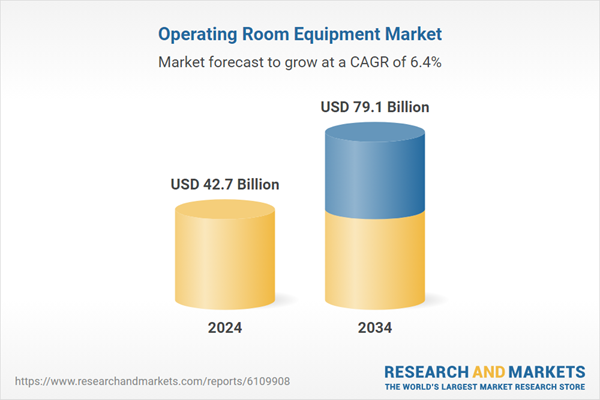Enhanced visualization and accurate data through these systems support better clinical decisions and faster recovery, aligning with the broader goal of expanding universal access to quality care. These advanced technologies allow surgeons and medical staff to monitor vital signs and internal structures in real time, significantly improving procedural outcomes and reducing the likelihood of complications. High-definition imaging, integrated software platforms, and AI-powered analytics contribute to more precise diagnostics and surgical planning. This level of insight not only reduces the invasiveness of procedures but also shortens hospital stays, minimizes readmission rates, and supports tailored post-operative care.
Among various product categories, patient monitoring systems segment held a 25.2% share in 2024. Surgeons and anesthesiologists rely heavily on these systems for real-time tracking of vital signs like oxygen saturation, ECG, and blood pressure during surgical procedures. The demand is strong for high-risk surgeries such as cardiac, neurological, and organ transplants, where accuracy and continuous feedback are critical. Advanced monitoring devices equipped with alarm settings and data trend capabilities are being widely adopted to ensure patient safety and support clinical decision-making in time-sensitive environments. As surgical procedures become more complex, reliable intraoperative monitoring helps in reducing complications and improving surgical outcomes, thus boosting the demand for high-performance monitoring solutions.
The general surgery segment generated USD 13.1 billion in 2024 and continues to be a major driver of equipment demand. Routine procedures such as hernia repairs, gallbladder removals, and appendectomies contribute to a consistent procedural volume across global markets. This steady demand fuels recurring investments in essential operating room tools including anesthesia systems, surgical tables, electrosurgical units, and surgical lighting. As hospitals aim to reduce case delays and optimize surgical scheduling, there is greater pressure to enhance operating room productivity. General surgery departments, which handle a high volume of procedures with varying durations, are particularly focused on replacing outdated infrastructure and adopting systems that facilitate rapid case turnaround and better resource utilization.
U.S. Operating Room Equipment Market generated USD 17.4 billion in 2024 and is estimated to reach USD 31.9 billion by 2034. The country’s high surgical procedure rate is primarily driven by its aging population and widespread chronic diseases such as obesity, cancer, and cardiovascular issues. The growing procedural demand has compelled hospital systems and surgical centers to invest in advanced operating room technologies. Institutions ranging from academic medical centers to large healthcare networks allocate significant capital budgets to upgrade or expand their surgical infrastructure. This enables them to improve care quality, reduce surgical wait times, and keep pace with evolving clinical standards. The consistent modernization of OR environments continues to drive robust growth across the U.S. market landscape.
Leading players contributing to the development of this industry include Getinge, Stryker, Olympus, Medtronic, GE HealthCare, Philips, Karl Storz, Smith & Nephew, Siemens Healthineers, Drägerwerk, Zimmer Biomet, B. Braun, Johnson & Johnson, Baxter International, and Mindray. To maintain a strong competitive edge, companies operating in the OR equipment market are adopting a range of targeted strategies. These include expanding product portfolios through innovation in imaging, integration, and robotic technologies. Many are focusing on partnerships with hospitals and surgical centers to offer bundled solutions or turnkey operating room installations. Investments in R&D for minimally invasive tools and AI-powered systems are also helping players meet the growing need for smart surgical environments.
Comprehensive Market Analysis and Forecast
- Industry trends, key growth drivers, challenges, future opportunities, and regulatory landscape
- Competitive landscape with Porter’s Five Forces and PESTEL analysis
- Market size, segmentation, and regional forecasts
- In-depth company profiles, business strategies, financial insights, and SWOT analysis
This product will be delivered within 2-4 business days.
Table of Contents
Companies Mentioned
- B. Braun
- Baxter International
- Dragerwerk
- GE HealthCare
- Getinge
- Johnson & Johnson
- Karl Storz
- Medtronic
- Mindray
- Olympus
- Philips
- Siemens Healthineers
- Smith & Nephew
- Stryker
- Zimmer Biomet
Table Information
| Report Attribute | Details |
|---|---|
| No. of Pages | 130 |
| Published | June 2025 |
| Forecast Period | 2024 - 2034 |
| Estimated Market Value ( USD | $ 42.7 Billion |
| Forecasted Market Value ( USD | $ 79.1 Billion |
| Compound Annual Growth Rate | 6.4% |
| Regions Covered | Global |
| No. of Companies Mentioned | 15 |









